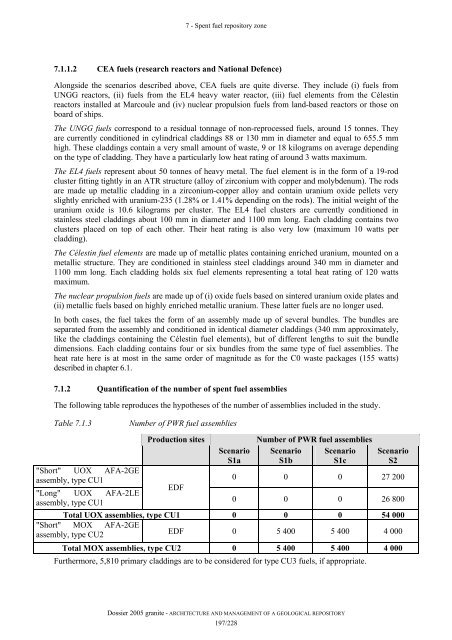Tome Architecture and management of a geological repository - Andra
Tome Architecture and management of a geological repository - Andra
Tome Architecture and management of a geological repository - Andra
Create successful ePaper yourself
Turn your PDF publications into a flip-book with our unique Google optimized e-Paper software.
7 - Spent fuel <strong>repository</strong> zone7.1.1.2 CEA fuels (research reactors <strong>and</strong> National Defence)Alongside the scenarios described above, CEA fuels are quite diverse. They include (i) fuels fromUNGG reactors, (ii) fuels from the EL4 heavy water reactor, (iii) fuel elements from the Célestinreactors installed at Marcoule <strong>and</strong> (iv) nuclear propulsion fuels from l<strong>and</strong>-based reactors or those onboard <strong>of</strong> ships.The UNGG fuels correspond to a residual tonnage <strong>of</strong> non-reprocessed fuels, around 15 tonnes. Theyare currently conditioned in cylindrical claddings 88 or 130 mm in diameter <strong>and</strong> equal to 655.5 mmhigh. These claddings contain a very small amount <strong>of</strong> waste, 9 or 18 kilograms on average dependingon the type <strong>of</strong> cladding. They have a particularly low heat rating <strong>of</strong> around 3 watts maximum.The EL4 fuels represent about 50 tonnes <strong>of</strong> heavy metal. The fuel element is in the form <strong>of</strong> a 19-rodcluster fitting tightly in an ATR structure (alloy <strong>of</strong> zirconium with copper <strong>and</strong> molybdenum). The rodsare made up metallic cladding in a zirconium-copper alloy <strong>and</strong> contain uranium oxide pellets veryslightly enriched with uranium-235 (1.28% or 1.41% depending on the rods). The initial weight <strong>of</strong> theuranium oxide is 10.6 kilograms per cluster. The EL4 fuel clusters are currently conditioned instainless steel claddings about 100 mm in diameter <strong>and</strong> 1100 mm long. Each cladding contains twoclusters placed on top <strong>of</strong> each other. Their heat rating is also very low (maximum 10 watts percladding).The Célestin fuel elements are made up <strong>of</strong> metallic plates containing enriched uranium, mounted on ametallic structure. They are conditioned in stainless steel claddings around 340 mm in diameter <strong>and</strong>1100 mm long. Each cladding holds six fuel elements representing a total heat rating <strong>of</strong> 120 wattsmaximum.The nuclear propulsion fuels are made up <strong>of</strong> (i) oxide fuels based on sintered uranium oxide plates <strong>and</strong>(ii) metallic fuels based on highly enriched metallic uranium. These latter fuels are no longer used.In both cases, the fuel takes the form <strong>of</strong> an assembly made up <strong>of</strong> several bundles. The bundles areseparated from the assembly <strong>and</strong> conditioned in identical diameter claddings (340 mm approximately,like the claddings containing the Célestin fuel elements), but <strong>of</strong> different lengths to suit the bundledimensions. Each cladding contains four or six bundles from the same type <strong>of</strong> fuel assemblies. Theheat rate here is at most in the same order <strong>of</strong> magnitude as for the C0 waste packages (155 watts)described in chapter 6.1.7.1.2 Quantification <strong>of</strong> the number <strong>of</strong> spent fuel assembliesThe following table reproduces the hypotheses <strong>of</strong> the number <strong>of</strong> assemblies included in the study.Table 7.1.3Number <strong>of</strong> PWR fuel assemblies"Short" UOX AFA-2GEassembly, type CU1"Long" UOX AFA-2LEassembly, type CU1Production sitesEDFScenarioS1aNumber <strong>of</strong> PWR fuel assembliesScenario ScenarioS1b S1cScenarioS20 0 0 27 2000 0 0 26 800Total UOX assemblies, type CU1 0 0 0 54 000"Short" MOX AFA-2GEassembly, type CU2EDF 0 5 400 5 400 4 000Total MOX assemblies, type CU2 0 5 400 5 400 4 000Furthermore, 5,810 primary claddings are to be considered for type CU3 fuels, if appropriate.Dossier 2005 granite - ARCHITECTURE AND MANAGEMENT OF A GEOLOGICAL REPOSITORY197/228
















